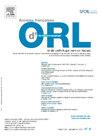自动化Sunnybrook面部评分系统的优化-提高面部地标深度学习网络的可靠性
Q4 Medicine
Annales Francaises d''Oto-Rhino-Laryngologie et de Pathologie Cervico-Faciale
Pub Date : 2025-02-01
DOI:10.1016/j.aforl.2025.01.001
引用次数: 0
摘要
目的Sunnybrook面部评分系统(SFGS)是一种完善的评估单侧面瘫严重程度和进展的评分系统。SFGS的自动化使研究人员、学生、正在培训的临床医生或其他未受过培训的同事更容易使用SFGS,并且可以在电子卫生环境中实施。本研究通过在先前开发的卷积神经网络(CNN)中添加面部地标层来研究对自动SFGS可靠性的影响。方法利用116例单侧周围性面瘫患者和9名健康人的SFGS姿势数据集,训练增加面部地标层的CNN。对SFGS的13个要素分别训练一个单独的模型,然后计算SFGS的分项得分和综合得分。自动分级系统的类内系数是基于三位有面瘫分级经验的临床医生计算的。结果与之前的模型相比,增加面部标志的CNN在所有综合得分上的表现都有所提高。SFGS综合评分的类内系数从0.87增加到0.91,静息对称性评分从0.45增加到0.62,自主运动对称性评分从0.89增加到0.92,协同运动评分从0.75增加到0.78。结论将面部地标层集成到CNN中,显著提高了自动SFGS的可靠性,达到了与人类观察者相当的性能水平。这些结果是在没有增加数据集的情况下获得的,强调了将面部地标纳入CNN的影响。这些发现表明,带有面部标志的自动SFGS是评估单侧周围性面瘫患者的可靠工具,适用于电子健康环境。本文章由计算机程序翻译,如有差异,请以英文原文为准。
Republication de : Optimization of the automated Sunnybrook Facial Grading System – Improving the reliability of a deep learning network with facial landmarks
Objective
The Sunnybrook Facial Grading System (SFGS) is a well-established grading system to assess the severity and progression of a unilateral facial palsy. The automation of the SFGS makes the SFGS more accessible for researchers, students, clinicians in training, or other untrained co-workers and could be implemented in an eHealth environment. This study investigated the impact on the reliability of the automated SFGS by adding a facial landmark layer in a previously developed convolutional neural network (CNN).
Methods
An existing dataset of 116 patients with a unilateral peripheral facial palsy and 9 healthy subjects performing the SFGS poses was used to train a CNN with a newly added facial landmark layer. A separate model was trained for each of the 13 elements of the SFGS and then used to calculate the SFGS subscores and composite score. The intra-class coefficient of the automated grading system was calculated based on three clinicians experienced in the grading of facial palsy.
Results
The inter-rater reliability of the CNN with the additional facial landmarks increased in performance for all composite scores compared to the previous model. The intra-class coefficient for the composite SFGS score increased from 0.87 to 0.91, the resting symmetry subscore increased from 0.45 to 0.62, the symmetry of voluntary movement subscore increased from 0.89 to 0.92, and the synkinesis subscore increased from 0.75 to 0.78.
Conclusion
The integration of a facial landmark layer into the CNN significantly improved the reliability of the automated SFGS, reaching a performance level comparable to human observers. These results were attained without increasing the dataset underscoring the impact of incorporating facial landmarks into a CNN. These findings indicate that the automated SFGS with facial landmarks is a reliable tool for assessing patients with a unilateral peripheral facial palsy and is applicable in an eHealth environment.
求助全文
通过发布文献求助,成功后即可免费获取论文全文。
去求助
来源期刊

Annales Francaises d''Oto-Rhino-Laryngologie et de Pathologie Cervico-Faciale
Medicine-Otorhinolaryngology
CiteScore
0.10
自引率
0.00%
发文量
93
审稿时长
51 days
 求助内容:
求助内容: 应助结果提醒方式:
应助结果提醒方式:


